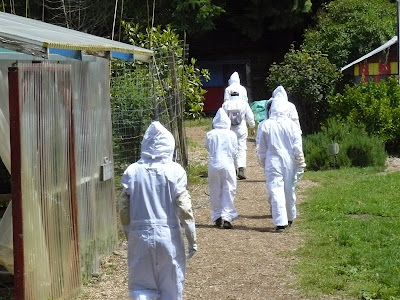Jarred Figlar-Barnes (center), of Elma, WA, explains the
benefits of work he has helped lead to restore McDonald Creek to USFWS managers
Submitted by: Miranda Plumb, fisheries biologist and Chehalis Fisheries Restoration Program coordinator
Region One Fisheries Assistant Regional Director, Mike
Carrier, Julie Collins (Deputy Assistant Regional Director), Jana Grote (Fisheries Supervisor), Tom
McDowell (Supervisory Fish and Wildlife biologist), Curtis Tanner (Supervisory
Fish and Wildlife biologist) and Miranda Plumb (Chehalis Fisheries Restoration Program Coordinator coordinator) recently shared an opportunity to learn about restoring
fish habitat from a young stream steward.
Jarred Figlar-Barnes, a senior at Elma High School, wrote a successful
grant proposal to replace a fish passage barrier (undersized culvert) with a
bridge, opening up several miles of this small stream.
Jarred told the group of USFWS biologists and managers visiting the site, “these small streams don’t get enough attention.”
Jarred’s work to help restore MacDonald Creek began a few years ago when he heard stories from local fishermen and farmers recounting the days when coho came up the creek to spawn. Jarred surveyed the watershed on his bicycle when he was 14 years old, identifying fish passage barriers associated with roads, railroads, and driveways. He then got to work to fix the problems he found.
Jared shares map of McDonald Creek
At 16
years old, Jared wrote his first successful grant application and received $10,000
from the Washington Department of Ecology’s Terry Husseman Account to fix a small
concrete blockage on McDonald Creek. The
next grant Jarred and his partners, the Grays Harbor Stream Team and Chehalis
Basin Fisheries Task Force, received was $66,000 from the Salmon Recovery
Funding Board. That funding was used to
correct the lowest fish passage barrier on McDonald Creek which was a ‘shotgun’
culvert on a farm access road.
Jarred rattled off an impressive list of fish species that had been found in the creek, including coho salmon, steelhead trout, Olympic mudminnow, cutthroat trout, and speckled and long-nosed dace. "Olympic mudminnow is my favorite!" he admitted.
The
group agreed that Jarred’s efforts were impressive, and that he was making a
real difference in his community, and the Chehalis River basin.
Jarred is one of several partners working with the USFWS
Chehalis Fisheries Restoration Program (CFRP) that ARD Mike Carrier met with on
his tour of basin fish habitat restoration projects. The goals of the CFRP are to restore or
improve spawning and rearing habitat, improve water quality, and increase
public awareness. The CFRP funds and
provides technical assistance to many different habitat restoration projects
such as fish passage barrier removals, riparian planting, invasive species
removals, estuary fishery assessments, and education and outreach. Fisheries Biologist Miranda Plumb organized
the tour, highlighting recent successes to restore habitat and provide outreach
and education opportunities for local school children.
Student journals along the Discovery Trail in Centralia
The group first visited a local nature and
education trail, the Discovery Trail in Centralia, with partners from the
Chehalis Basin Education Consortium and Chehalis River Basin Land Trust. Then they went on to see the results of a
fish passage barrier removal and culvert replacement on a county road near
Oakville which opened 12 miles of stream habitat with partner Lonnie Crumley,
the director of the Chehalis Basin Fisheries Task Force.
In the afternoon, the group headed to the
Grays Harbor estuary where they first met with the Quinault Indian Nation and Natural
Resources Consultants, Inc. who partner with The Nature Conservancy to remove
derelict fishing gear (e.g. lost fishing nets and crab pots) from the Chehalis
River and estuary. Lastly, we saw the
multifaceted restoration work that is happening at the WA Department of Natural
Resources on Preacher’s Slough which is part of the Chehalis River Surge Plain
Natural Area Preserve.
Team members inspect fishing gear recovered from the Chehalis River
All photo credits: USFWS





















+(1).JPG)







